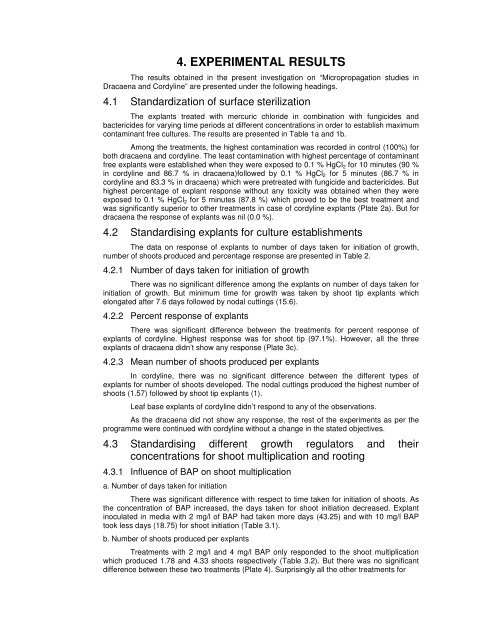micropropagation studies in dracaena and cordyline - ETD ...
micropropagation studies in dracaena and cordyline - ETD ...
micropropagation studies in dracaena and cordyline - ETD ...
You also want an ePaper? Increase the reach of your titles
YUMPU automatically turns print PDFs into web optimized ePapers that Google loves.
4. EXPERIMENTAL RESULTS<br />
The results obta<strong>in</strong>ed <strong>in</strong> the present <strong>in</strong>vestigation on “Micropropagation <strong>studies</strong> <strong>in</strong><br />
Dracaena <strong>and</strong> Cordyl<strong>in</strong>e” are presented under the follow<strong>in</strong>g head<strong>in</strong>gs.<br />
4.1 St<strong>and</strong>ardization of surface sterilization<br />
The explants treated with mercuric chloride <strong>in</strong> comb<strong>in</strong>ation with fungicides <strong>and</strong><br />
bactericides for vary<strong>in</strong>g time periods at different concentrations <strong>in</strong> order to establish maximum<br />
contam<strong>in</strong>ant free cultures. The results are presented <strong>in</strong> Table 1a <strong>and</strong> 1b.<br />
Among the treatments, the highest contam<strong>in</strong>ation was recorded <strong>in</strong> control (100%) for<br />
both <strong>dracaena</strong> <strong>and</strong> cordyl<strong>in</strong>e. The least contam<strong>in</strong>ation with highest percentage of contam<strong>in</strong>ant<br />
free explants were established when they were exposed to 0.1 % HgCl2 for 10 m<strong>in</strong>utes (90 %<br />
<strong>in</strong> cordyl<strong>in</strong>e <strong>and</strong> 86.7 % <strong>in</strong> <strong>dracaena</strong>)followed by 0.1 % HgCl2 for 5 m<strong>in</strong>utes (86.7 % <strong>in</strong><br />
cordyl<strong>in</strong>e <strong>and</strong> 83.3 % <strong>in</strong> <strong>dracaena</strong>) which were pretreated with fungicide <strong>and</strong> bactericides. But<br />
highest percentage of explant response without any toxicity was obta<strong>in</strong>ed when they were<br />
exposed to 0.1 % HgCl2 for 5 m<strong>in</strong>utes (87.8 %) which proved to be the best treatment <strong>and</strong><br />
was significantly superior to other treatments <strong>in</strong> case of cordyl<strong>in</strong>e explants (Plate 2a). But for<br />
<strong>dracaena</strong> the response of explants was nil (0.0 %).<br />
4.2 St<strong>and</strong>ardis<strong>in</strong>g explants for culture establishments<br />
The data on response of explants to number of days taken for <strong>in</strong>itiation of growth,<br />
number of shoots produced <strong>and</strong> percentage response are presented <strong>in</strong> Table 2.<br />
4.2.1 Number of days taken for <strong>in</strong>itiation of growth<br />
There was no significant difference among the explants on number of days taken for<br />
<strong>in</strong>itiation of growth. But m<strong>in</strong>imum time for growth was taken by shoot tip explants which<br />
elongated after 7.6 days followed by nodal cutt<strong>in</strong>gs (15.6).<br />
4.2.2 Percent response of explants<br />
There was significant difference between the treatments for percent response of<br />
explants of cordyl<strong>in</strong>e. Highest response was for shoot tip (97.1%). However, all the three<br />
explants of <strong>dracaena</strong> didn’t show any response (Plate 3c).<br />
4.2.3 Mean number of shoots produced per explants<br />
In cordyl<strong>in</strong>e, there was no significant difference between the different types of<br />
explants for number of shoots developed. The nodal cutt<strong>in</strong>gs produced the highest number of<br />
shoots (1.57) followed by shoot tip explants (1).<br />
Leaf base explants of cordyl<strong>in</strong>e didn’t respond to any of the observations.<br />
As the <strong>dracaena</strong> did not show any response, the rest of the experiments as per the<br />
programme were cont<strong>in</strong>ued with cordyl<strong>in</strong>e without a change <strong>in</strong> the stated objectives.<br />
4.3 St<strong>and</strong>ardis<strong>in</strong>g different growth regulators <strong>and</strong> their<br />
concentrations for shoot multiplication <strong>and</strong> root<strong>in</strong>g<br />
4.3.1 Influence of BAP on shoot multiplication<br />
a. Number of days taken for <strong>in</strong>itiation<br />
There was significant difference with respect to time taken for <strong>in</strong>itiation of shoots. As<br />
the concentration of BAP <strong>in</strong>creased, the days taken for shoot <strong>in</strong>itiation decreased. Explant<br />
<strong>in</strong>oculated <strong>in</strong> media with 2 mg/l of BAP had taken more days (43.25) <strong>and</strong> with 10 mg/l BAP<br />
took less days (18.75) for shoot <strong>in</strong>itiation (Table 3.1).<br />
b. Number of shoots produced per explants<br />
Treatments with 2 mg/l <strong>and</strong> 4 mg/l BAP only responded to the shoot multiplication<br />
which produced 1.78 <strong>and</strong> 4.33 shoots respectively (Table 3.2). But there was no significant<br />
difference between these two treatments (Plate 4). Surpris<strong>in</strong>gly all the other treatments for

















